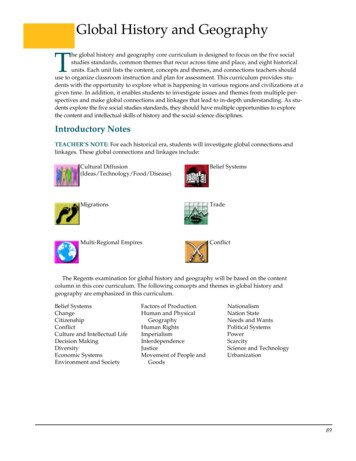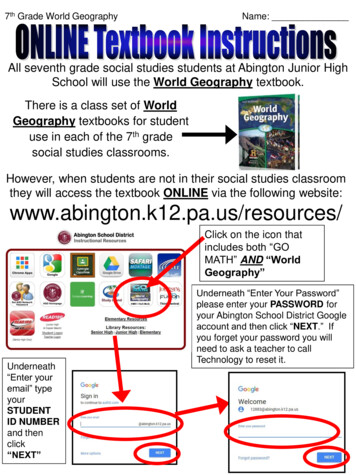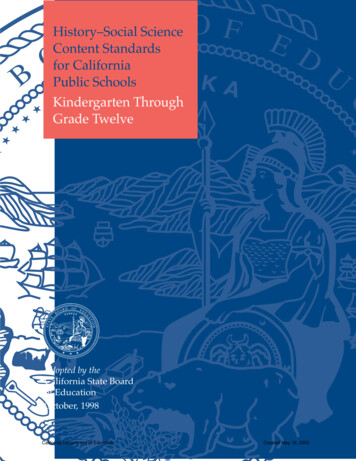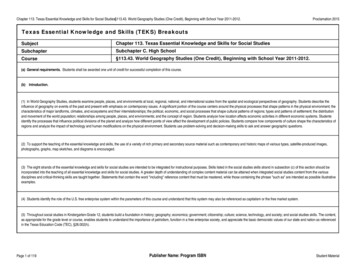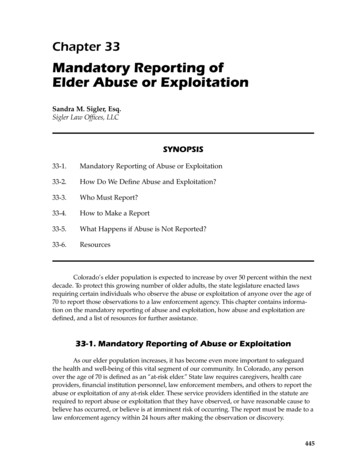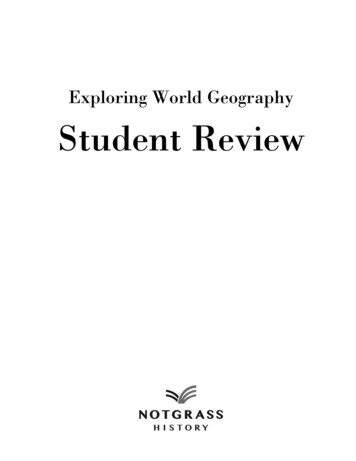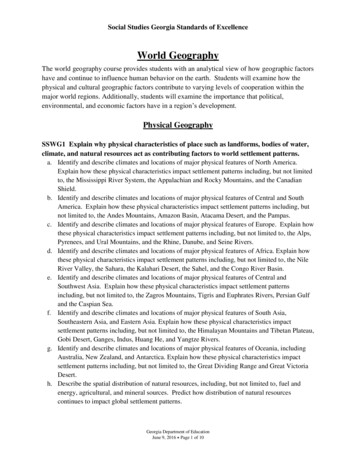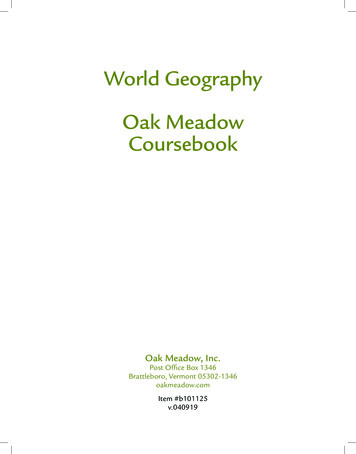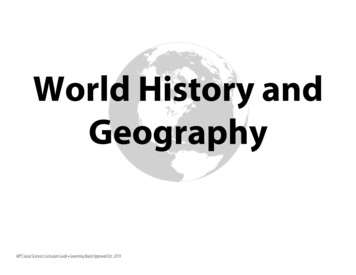
Transcription
World History andGeographyMPS Social Sciences Curriculum Guide Governing Board Approved Oct. 2019
IntroductionAn important aspect of our Republic is that an educated and engaged citizenry is vital for the system to work. In a government where the finalauthority and sovereignty rests with the people, our local, state, and federal governments will only be as responsive as the citizens demand them tobe. Preparing students for contemporary society cannot be accomplished without a strong emphasis on civics, economics, geography, and history –the core disciplines of the social sciences. It is imperative that each generation gains an understanding of the knowledge, skills, and dispositions toparticipate fully in civic life in a rapidly changing world.The emphasis on content knowledge, disciplinary skills and processes, and the integration of inquiry elements will prepare students of Mesa PublicSchools to engage actively in their community and meet the needs of the 21st century.Engaging students in the pursuit of active, informed citizenship will require a broad range of understandings and skills including:Think analytically Pose and frame questionsGather a variety of evidenceRecognize continuity and detect change over timeUtilize chronology to examine cause and effect relationshipsDraw and combine reasonable inferences from a variety of sources to build an understanding of complex questionsRead widely and critically Examine, interpret, and contextualize primary sources focusing on author, purpose, and audience of each sourceIdentify and compare historical, geographic, economic, and political science interpretations from a wide variety of secondary sourcesUtilize broader understanding to discern subtext in primary and secondary sourcesCommunicate cogently and in a compelling manner Develop and defend evidenced based argumentsUtilize multiple perspectives for comprehensive explanationsPractice and cultivate a wide variety of diverse types of writingEngage in constructive conversations around history and social science topicsMPS Social Sciences Curriculum Guide Governing Board Approved Oct. 2019i
Anchor StandardsThe Arizona History and Social Science Standards are organized into five content areas. Within these content areas are major core concepts referred toas Anchor Standards. One core concept within the standards is the Disciplinary Skills and Processes. These Disciplinary Skills and Process standardsprovide the vehicle for which content is to be delivered. They can apply to any historical era, context, or content area and provide the toolsstudents need to think like historians, geographers, political scientists, and economists. These skills and processes are especially critical in a time whenstudents are exposed to massive amounts of information in numerous forms and must develop skills to make sense of the information theyobtain. Grade level standards are (then) written to support these Anchor Standards and progress as the student moves through grade levels.Disciplinary Skills and ProcessesSP1: Chronological reasoning requiresunderstanding processes of change andcontinuity over time, which means assessingsimilarities and differences between historicalperiods and between the past and present.CivicsC1: Civic virtues anddemocratic principles arekey components of theAmerican political system.EconomicsE1: A financially literateindividual understands how tomanage income, spending,and investment.GeographyG1: The use ofgeographicrepresentations and toolshelps individualsunderstand their world.HistoryH1: The development of civilizations,societies, cultures, and innovationshave influenced history andcontinue to impact the modernworld.SP2: Thinking within the discipline involvesthe ability to identify, compare, and evaluatemultiple perspectives about a given event todraw conclusions about that event sincethere are multiple points of view aboutevents and issues.C2: Citizens have individualrights, roles, andresponsibilities.E2: By applying economicreasoning, individuals seek tounderstand the decisions ofpeople, groups, and societies.G2: Human-environmentinteractions are essentialaspects of human life inall societies.H2: Cycles of conflict andcooperation have shaped relationsamong people, places, andenvironments.SP3: Historians and social scientists gather,interpret, and use evidence to develop claimsand answer historical, economic,geographical, and political questions andcommunicate their conclusions.C3: An understanding ofcivic and politicalinstitutions in society andthe principles theseinstitutions are intended toreflect including knowledgeabout law, politics, andgovernment are essential toeffective citizenship.E3: Individuals and institutionsare interdependent withinmarket systems.G3: Examining humanpopulation andmovement helpsindividuals understandpast, present, and futureconditions on Earth’ssurface.H3: Economic, political, and religiousideas and institutions haveinfluenced history and continue toshape the modern world.SP4: Thinking within the discipline involvesthe ability to analyze relationships amongcauses and effects and to create and supportarguments using relevant evidence.C4: Process, rules, and lawsdirect how individuals aregoverned and how societyaddresses problems.E5: The interconnected globaleconomy impacts allindividuals and groups insignificant and varied ways.G4: Globalinterconnections andspatial patterns are anecessary part ofgeographic reasoning.H4: Patterns of social and politicalinteractions have shaped people,places, and events throughouthistory and continue to shape themodern world.MPS Social Sciences Curriculum Guide Governing Board Approved Oct. 2019E4: The domestic economy isshaped by interactionsbetween government,institutions, and the privatesectoriii
The 21 Anchor Standards are represented within each of the grade bands; K-2, 3-5, 6-8, and high school, but not all Anchor Standards are at each gradelevel. Specific grade level standards are organized under each of the Anchor Standards.MPS Social Sciences Curriculum Guide Governing Board Approved Oct. 2019iv
Inquiry ArcChildren and adolescents are naturally curious and have unlimited questions. Learning to investigate questions in the social studies discipline areasresults in a deeper understanding of content and a stronger connection to the material. Students must gather and evaluate evidence, formulatearguments, critique counter claims, and communicate their conclusions through many modes including writing, speaking, and visualizing. The sixcomponents of the Inquiry Arc are found in the Disciplinary Skills and Processes Anchor Standards and appear at each grade level. Incorporatinginquiry using the content standards reinforces the same skills and processes contained in the Arizona English Language Arts (ELA) standards. Asstudents utilize inquiry processes in their content area, they reinforce and use the ELA reading, writing, speaking, and listening standards.The Six Elements of the Inquiry Arc Inquiry Element 1: Developing Compelling QuestionsCentral to a rich social studies experience is the capability for developing questions that can frame and advance inquiry. Those questions come in two forms:compelling and supporting questions. Compelling questions focus on enduring issues and concerns. Inquiry Element 2: Constructing Supporting QuestionsSupporting questions focus on descriptions, definitions, and processes in which there is general agreement within the social studies disciplines and requirestudents to construct explanations that advance claims of understanding in response. Inquiry Element 3: Gathering and Evaluating SourcesStudents, whether they are constructing opinions, explanations, or arguments, gather information from a variety of sources and evaluate the relevance ofthe information. In evaluating these sources there are literacy skills, such as identifying an author’s purpose, main idea, and point of view, that will help inevaluating the usefulness of a source. Inquiry Element 4: Developing ClaimsOnce students analyze information, they need to develop claims and counterclaims to answer social studies questions. Evidence is used to support theseclaims. Inquiry Element 5: Communicating ConclusionsStudents formalize their arguments and explanations and communicate their results through various products to a wide range of audiences. Students alsohave the opportunity to critique their scholarship as well as the scholarship of others. Inquiry Element 6: Taking Informed ActionTo prepare students for civic life, students use their disciplinary knowledge, skills, and perspectives to inquire about problems involved in public issues,deliberate with others on how to define and address these issues, take constructive and collaborative action, and reflect on that action.MPS Social Sciences Curriculum Guide Governing Board Approved Oct. 2019v
Design and CodingEach standard is made up of three components. The grade level appears first, followed by the core discipline Big Idea, and finally a standard number.The standard number at the end of the code is designed for recording purposes and does not imply instructional sequence or importance. Examplesand explanations of the coding are reflected here.MPS Social Sciences Curriculum Guide Governing Board Approved Oct. 2019vi
Standards v. Curriculum v. InstructionStandards:Standards are what a student needs to know, understand, and be able to do by the end of each grade. They build across grade levels in aprogression of increasing understanding and through a range of cognitive demand levels. Standards are adopted at the state level by the ArizonaState Board of Education.Curriculum:Curriculum refers to resources used for teaching and learning the standards. Curricula are adopted at the local level.Instruction:Instruction refers to the methods, or methodologies, used by teachers to teach their students. Instructional techniques are employed by individualteachers in response to the needs of the students in their classes to help them progress through the curriculum to master the standards. Decisionsabout instructional practice and techniques are made at a local level.MPS Social Sciences Curriculum Guide Governing Board Approved Oct. 2019vii
Scope and SequenceHigh School Social Studies: World History and GeographyThrough the process of inquiry, students will engage in a comprehensive study of world history through a balanced approach to both Eastern andWestern Hemispheres. The course starts with content beginning in the 15th century and moves to current issues and events. Connections to geographictopics and concepts will be integrated throughout the course.Unit #Title1Foundations of World History2Global Interactions andCultural Differences3Revolutions4Rise of Nations and GlobalConflict5Contemporary Global IssuesCritical ContentWorld Belief SystemsGeography Skills (maps, imagery, geospatial technologies, charts, graphs, andtables)Global Culture and DiffusionGlobal Exploration (Trans-Atlantic slave trade, Columbian exchange)Development of EmpiresPopulation, Movement, and Migration (global migration patterns)Revolutions of Thought (Renaissance, Science, Enlightenment, Reformation)Industrial RevolutionRevolutions of Government and Politics (North America, Latin America, France)Geographic Political DevelopmentRise of Nations (Imperialism, Nationalism, rise of Fascism, rise of Communism)Global Conflict (World Wars, Cold War)Conflict Resolution (geographic patterns of global power, treaties,supranational organizations, and decolonization)Regional Conflicts (Genocide, Human Rights, USSR, Fall of USSR)Global TerrorismGlobalization (human interaction with the environment , human migrationand settlement patterns, geographic issues, global interconnections,sustainability, population issues, and economic development)MPS Social Sciences Curriculum Guide Governing Board Approved Oct. 2019Approximate Time3 weeks6 weeks8 weeks12 weeks6 weeks1
Disciplinary Skills and ProcessesHigh School Social Studies: World History and GeographyUnits1 – Foundations of World History2 – Global Interactions and Cultural Diffusion3 – Revolutions4 – Rise of Nations and Global Conflict5 – Contemporary Global IssuesDISCIPLINARY SKILLS and PROCESSES: Use this chart to track usage of SP standards throughout the units.Shaded boxes indicate suggested use of the standard in that specific unit. Teaching of the standards is expectedthroughout the course.UNITS:12345Chronological reasoning requires understanding processes of change and continuity over time, which means assessingsimilarities and differences between historical periods and between the past and present.HS.SP1.1 Evaluate how events and developments were shaped by unique circumstances of time and place as well as broader contexts.HS.SP1.2 Analyze change and continuity in historical eras.HS.SP1.3 Evaluate the significance of past events as they relate to their own lives and the world.HS.SP1.4 Use compelling questions generated about individuals and groups to assess how the significance of their actions changes over time and is shapedby the historical context.Thinking within the discipline involves the ability to identify, compare, and evaluate multiple perspectives about a given event todraw conclusions about that event since there are multiple points of view about events and issues.HS.SP2.1 Analyze how contexts shaped and continue to shape people’s perspectives.HS.SP2.2 Analyze the ways in which perspective shapes recorded history.HS.SP2.3 Demonstrate historical empathy when examining individuals or groups in the past whose perspectives might be very different from those heldtoday.Historians and social scientists gather, interpret, and use evidence to develop claims and answer historical, economic,geographical, and political questions and communicate their conclusions.HS.SP3.1 Develop and frame questions about issues and events in the discipline and determine the types of sources that will be helpful in answering thesequestions.HS.SP3.2 Gather relevant information from multiple sources representing a wide range of views while using origin, authority, structure, context, andcorroborative value of the source to guide the selection.MPS Social Sciences Curriculum Guide Governing Board Approved Oct. 20192
World History Disciplinary SkillsDISCIPLINARY SKILLS and PROCESSESUNITS:12345HS.SP3.3 Analyze the relationship between primary sources and the secondary interpretations made from them including possible limitations in various kindsof evidence and differing secondary interpretations.HS.SP3.4 Evaluate the credibility of a source by examining how experts value the source.HS.SP3.5 Use questions generated about multiple historical sources to pursue further inquiry and investigate additional sources.HS.SP3.6 Construct and present arguments using precise and knowledgeable claims, with evidence from multiple sources, while acknowledgingcounterclaims and evidentiary weaknesses.HS.SP3.7 Construct and present explanations using sound reasoning, correct sequence (linear and non-linear) examples, and details with significant andpertinent information and data, while acknowledging the strengths and weaknesses of the explanation.HS.SP3.8 Present arguments and explanations that feature ideas and perspectives on issues and topics to reach a range of audiences and venues using print,oral, and digital technologies.Thinking within the discipline involves the ability to analyze relationships among causes and effects and to create and supportarguments using relevant evidence.HS.SP4.1 Analyze multiple and complex causes and effects of events in the past and present.HS.SP4.2 Distinguish between long-term causes and triggering events in developing an argument.HS.SP4.3 Integrate evidence from multiple relevant sources and interpretations into a reasoned argument.HS.SP4.4 Compare the central arguments in secondary works on related topics in multiple media. Critique the central arguments in secondary works onrelated topics in multiple media in terms of their accuracy and relevance.MPS Social Sciences Curriculum Guide Governing Board Approved Oct. 20193
World History Unit 1:Foundations of World HistoryCompelling Question: How do beliefs and religion shape societies?Time: 3 WeeksDisciplinary Skills and Processes:Lessons should be designed around Disciplinary Skills and Process (SP) Standards. The SP standards are the vehicle through which content standards are to bedelivered. SP standards are to be taught multiple times throughout the year, with mastery by the end of the course. Refer to the Disciplinary Skills and ProcessStandards Chart above and determine the appropriate standards to frame your instruction within units. Track used standards on the chart.Content StandardsLearning TargetsHS.H1.5 Explain how religions and belief systems have affected theorigins of societies.I can analyze a variety of world belief systems. (HS.H1.5)HS.G1.1 Use geographic data to explain and analyze relationshipsbetween locations of place and regions (e.g., maps, remotely sensed andother images, tables, and graphs).I can analyze a map of belief systems, cultural diffusion, and/or civilizations.(HS.G1.1)HS.G1.2 Use geospatial tools and related technologies to constructrelevant geographic data to explain spatial patterns andrelationships (e.g., Google Earth, story mapping, wayfaring apps, andother geospatial technologies).I can use images, tables, and graphs to interpret geographic relationshipsbetween places and regions within the context of this unit. (HS.G1.1)I can explain how societies developed based on their belief systems. (HS.H1.5)I can examine religion and belief systems at local to global scales. (HS.G1.1)Key Concepts/Topicsworld belief systems: origins,founders, major tenets, practicesand sacred writings (i.e., Hinduism,Buddhism, Judaism, Christianity,Islam, Confucianism, Taoism,Shintoism, Sikhism)cultural diffusiongeography skillsI can construct a visual representation (e.g., map, chart, or graph) ofgeographic data within the context of this unit. (HS.G1.2)I can analyze how belief systems shaped and continues to shape people'sperspectives. (HS.SP2.1)I can identify the difference between primary and secondary sources whendiscussing World Belief Systems and Cultural Diffusion. (HS.SP3.1)I can develop compelling questions about World Belief Systems to supportinquiry. (HS.SP3.1)I can evaluate if a source is credible when discussing World Belief Systems andCultural Diffusion. (HS.SP3.4)Supporting QuestionsWhat is a belief system?What is the difference between a map, an image, a table, and a graph?What is a religion?What are the components of a map?How are belief systems similar and different?How do geographic tools aid historical analysis?What is cultural diffusion?What are the characteristics of a society?i.e. indicates requirements; e.g. indicates suggestionsMPS Social Sciences Curriculum Guide Governing Board Approved Oct. 2019 4
World History Unit 2:Global Interactions and Cultural DiffusionCompelling Question: Is sharing and trading across cultures always a good thing?Time: 6 WeeksDisciplinary Skills and Processes:Lessons should be designed around Disciplinary Skills and Process (SP) Standards. The SP standards are the vehicle through which content standards are to bedelivered. SP standards are to be taught multiple times throughout the year, with mastery by the end of the course. Refer to the Disciplinary Skills and ProcessStandards Chart above and determine the appropriate standards to frame your instruction within units. Track used standards on the chart.Content StandardsHS.H1.1 Explain the process of state-building, expansion, anddissolution.HS.H1.2 Explain and compare how social, cultural, and environmentalfactors influenced state-building, expansion, and dissolution.HS.H1.3 Evaluate the consequences that resulted from civilizationaland cultural interactions.HS.H1.4 Analyze the impact of cultural diffusion.HS.H1.7 Analyze how technological innovation and trade hasaffected economic development and transformed societies.HS.G2.2 Evaluate how political and economic decisions throughouttime have influenced cultural and environmental characteristics ofvarious places and regions.HS.G3.1 Analyze the reciprocal nature of how historical events andthe diffusion of ideas, technologies, and cultural practices haveinfluenced migration patterns and the distribution of humanpopulation.Learning TargetsKey Concepts/TopicsI can define and identify examples of cultural diffusion. (HS.H1.4)European explorationI can evaluate the causes and effects of European Exploration. (HS.H1.3, HS.H1.1)Trans-African and Trans-Atlanticslave systems (e.g., labor systems)I can evaluate the consequences of trade over land and sea. (HS.H1.3)I can identify different perspectives of history when discussing Exploration andEmpires. (HS.SP2.1)land and oceanic trade systems (i.e.,The Silk Road, Indian Ocean TradeRoutes)I can analyze why people develop different perspectives of historical events withinthe context of this unit. (HS.SP2.1)Columbian ExchangeI can analyze the ways in which perspective shapes recorded history regardingExploration and Empires. (HS.SP2.2)I can explain the concept of historical empathy within the context of this unit.(HS.SP2.3)global migration patternsdevelopment and dissolution ofempires (i.e., Ottoman, Mughal,Aztec, Inca, Mali, Ming Dynasty)I can analyze the impact of the Columbian Exchange on all civilizations involved.(HS.H1.4)I can analyze the impact of the silk road on the diffusion of technology andculture. (HS.H1.4, HS.H1.7)I can analyze the role technology plays in the growth of empires and exploration.(HS.H1.7)I can analyze how trade has affected the economic development of societies.(HS.H1.7)I can analyze how trade and technology have transformed societies. (HS.H1.7)I can evaluate the cultural and environmental effects of government decisions ontheir homelands and areas they encounter. (HS.G2.2)i.e. indicates requirements; e.g. indicates suggestionsMPS Social Sciences Curriculum Guide Governing Board Approved Oct. 2019 5
World History Unit 2I can evaluate the cultural and environmental effects of economic decisions andhow they affect multiple world regions. (HS.G2.2)I can analyze how events, ideas, technology, and cultural practices create pushpull factors that encourage human migrations. (HS.G3.1)I can create questions about exploration and empires and determine the types ofsources that will be helpful in answering those questions. (HS.SP.3.1, HS.SP3.4)I can evaluate the credibility of a source about exploration and empires byexamining how experts value the source. (HS. SP3.4)I can explain how and why empires are built and why they expand. (HS.H1.1,HS.H1.2)I can compare the social, cultural, and environmental factors that influenced thebuilding and expanding of multiple empires. (HS.H1.2)I can explain how and why empires dissolved. (HS.H1.1)I can compare the social, cultural, and environmental factors that influenced thehow and why empires dissolved. (HS.H1.2)I can empathize with people in history whose lives are different than my ownwithin the context of this unit. (HS.SP2.3)Supporting QuestionsWhat is cultural diffusion?Where and why do populations concentrate?What were the causes of European exploration?What is an empire?What were the impacts of European exploration?How do empires impact trade?What trade routes were popularized because of European Exploration?Why do empires develop?What labor systems, including slavery, were used by Europeans?Why do empires dissolve?How did European culture become dominant in other places?What is migration?What was the Columbian Exchange?What factors influence human migration?Why would it be advantageous to look for alternate trade routes?i.e. indicates requirements; e.g. indicates suggestionsMPS Social Sciences Curriculum Guide Governing Board Approved Oct. 2019 6
World History Unit 3: RevolutionsCompelling Question: What causes society to make up sudden radical changes?Time: 8 WeeksDisciplinary Skills and Processes:Lessons should be designed around Disciplinary Skills and Process (SP) Standards. The SP standards are the vehicle through which content standards are to bedelivered. SP standards are to be taught multiple times throughout the year, with mastery by the end of the course. Refer to the Disciplinary Skills and ProcessStandards Chart above and determine the appropriate standards to frame your instruction within units. Track used standards on the chart.Content StandardsLearning TargetsKey Concepts/TopicsHS.H3.1 Analyze how societies, leaders, institutions, andorganizations respond to societal needs and changes.I can evaluate the significance of contributions made by people of theRenaissance, Scientific Revolution, Enlightenment, and Reformation. (HS.SP1.4)HS.H3.2 Analyze how ideologies, religion, and belief systems haveinfluenced economic, political, and social institutions over time.I can analyze how the needs of society during the revolutions of thought areanswered by leaders, institutions, and organizations. (HS. H3.1)HS.H3.3 Compare the ways in which economic philosophiesinfluenced political, economic, and social developments.I can analyze how the needs of society during the Industrial Revolution areanswered by leaders, institutions, and organizations. (HS. H3.1)HS.H3.4 Evaluate how societies have balanced individual freedoms,responsibilities, and human dignity versus the common good.I can analyze how the needs of society during political revolutions areanswered by leaders, institutions, and organizations. (HS. H3.1)HS.H3.5 Explain how different labor systems developed and affectedsocieties over time.I can analyze how revolutions have influenced economic, political, and socialinstitutions. (HS.H3.2)HS.H4.1 Examine how historically marginalized groups have affectedchange on political and social institutions.I can compare the ways in which economic philosophies influenced political,economic, and social developments. (HS.H3.3)HS.H4.2 Explain how artistic, philosophical, and scientific ideas havedeveloped and shaped society and institutions.I can explain how societies have successfully balanced the needs of theindividual with the needs of the group. (HS.H3.4)HS.H4.3 Examine how access to information and technology hasbeen used to influence society.I can explain how societies have failed to balance the needs of the individualwith the needs of the group. (HS.H3.4)HS.G3.5 Evaluate the impact of social, political, and economicdecisions that have caused conflict or promoted cooperationthroughout time.I can explain how and why labor systems develop. (HS.H3.5)RenaissanceScientific RevolutionEnlightenmentReformationIndustrial Revolutioncapitalism, communism, and socialismrevolutions in government and politics(i.e., North America, Latin America,France)I can explain how labor systems affect societies. (HS.H3.5)I can identify what makes a group historically marginalized. (HS.H4.1)I can examine how historically marginalized groups have affected change onpolitical and social institutions. (HS.H4.1)I can explain how philosophical ideas have developed and shaped society andinstitutions. (HS.H4.2)i.e. indicates requirements; e.g. indicates suggestionsMPS Social Sciences Curriculum Guide Governing Board Approved Oct. 2019 7
World History Unit 3I can explain how scientific ideas have developed and shaped society andinstitutions. (HS.H4.2)I can examine how access to information and technology has been used toinfluence society during Revolutions of Thought. (HS.H4.3)I can examine how access to information and technology has been used toinfluence society during the Industrial Revolution. (HS.H4.3)I can examine how access to information and technology has been used toinfluence society during political revolutions. (HS.H4.3)I can identify the difference between social, political, and economic decisions.(HS.G3.5)I can evaluate how social, political, and economic choices cause conflict orcooperation. (HS.G3.5)I can explain how past events during the age of revolution affect my life today.(HS.SP1.3)Supporting QuestionsWhat is a revolution?What are the causes and outcomes of the Reformation?How did the Renaissance ideas of humanism and secularism change society?Who led and supported the ideals of the Reformation?Who led and supported Renaissance ideas?Where, why, and how did industry develop?What sudden and radical changes occurred in science during this time period?What are the impacts of the Industrial Revolution including short term problems and long termsolutions?What is the connection between the Scientific Revolution and the Industrial Revolution?Who led and supported the ideas of the Enlightenment?What is the connection between Enlightenment ideas and political revolutions?How did capitalism, communism, and socialism emerge as outcomes of the IndustrialRevolution?How did Enlightenment ideals influence political revolutions in France and the Americas?What changes occurred in France and the Americas due to their revolutions?i.e. indicates requirements; e.g. indicates suggestionsMPS Social Sciences Curriculum Guide Governing Board Approved Oct. 2019 8
World History Unit 4:Rise of Nations and Global ConflictCompelling Question: Does conflict make society worse or better?Time: 12 WeeksDisciplinary Skills and Processes:Lessons should be designed around Disciplinary Skills and Process (SP) Standards. The SP standards are the vehicle through which content standards are to bedelivered. SP standards are to be taught multiple times throughout the year, with mastery by the end of the course. Refer to the Disciplinary Skills and ProcessStandards Chart above and determine the appropriate standards to frame your instruction within units. Track used standards on the chart.Content StandardsLearning TargetsKey Concepts/TopicsHS.H2.1 E
High School Social Studies: World History and Geography Through the process of inquiry, students will engage in a comprehensive study of world history through a balanced approach to both Eastern and Western Hemispheres. The course starts with content beginning in the 15th century and move
